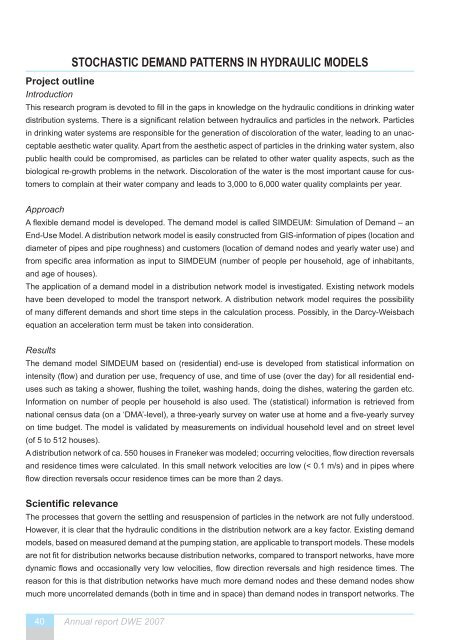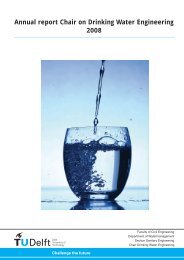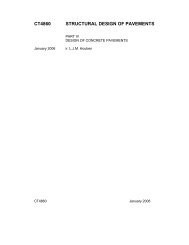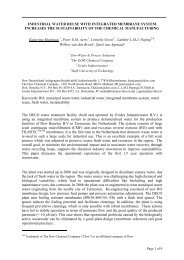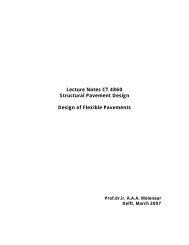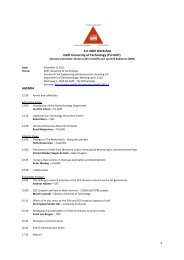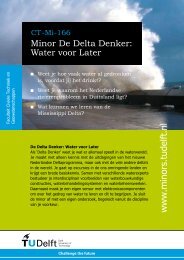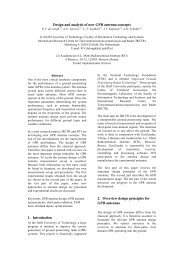Annual report Chair on Drinking Water Engineering 2007 - TU Delft
Annual report Chair on Drinking Water Engineering 2007 - TU Delft
Annual report Chair on Drinking Water Engineering 2007 - TU Delft
Create successful ePaper yourself
Turn your PDF publications into a flip-book with our unique Google optimized e-Paper software.
Project outline<br />
Introducti<strong>on</strong><br />
STOCHASTIC DEMAND PATTERNS IN HYDRAULIC MODELS<br />
���������������������������������������������������������������������������������������������������������������<br />
����������������������������������������������������������������������������������������������������������������<br />
in drinking water systems are resp<strong>on</strong>sible for the generati<strong>on</strong> of discolorati<strong>on</strong> of the water, leading to an unacceptable<br />
aesthetic water quality. Apart from the aesthetic aspect of particles in the drinking water system, also<br />
public health could be compromised, as particles can be related to other water quality aspects, such as the<br />
biological re-growth problems in the network. Discolorati<strong>on</strong> of the water is the most important cause for customers<br />
to complain at their water company and leads to 3,000 to 6,000 water quality complaints per year.<br />
Approach<br />
���������������������������������������������������������������������������������������������������<br />
End-Use Model. A distributi<strong>on</strong> network model is easily c<strong>on</strong>structed from GIS-informati<strong>on</strong> of pipes (locati<strong>on</strong> and<br />
diameter of pipes and pipe roughness) and customers (locati<strong>on</strong> of demand nodes and yearly water use) and<br />
�������������������������������������������������������������������������������������������������������<br />
and age of houses).<br />
The applicati<strong>on</strong> of a demand model in a distributi<strong>on</strong> network model is investigated. Existing network models<br />
have been developed to model the transport network. A distributi<strong>on</strong> network model requires the possibility<br />
of many different demands and short time steps in the calculati<strong>on</strong> process. Possibly, in the Darcy-Weisbach<br />
equati<strong>on</strong> an accelerati<strong>on</strong> term must be taken into c<strong>on</strong>siderati<strong>on</strong>.<br />
Results<br />
The demand model SIMDEUM based <strong>on</strong> (residential) end-use is developed from statistical informati<strong>on</strong> <strong>on</strong><br />
���������������������������������������������������������������������������������������������������������������<br />
������������������������������������������������������������������������������������������������������������<br />
Informati<strong>on</strong> <strong>on</strong> number of people per household is also used. The (statistical) informati<strong>on</strong> is retrieved from<br />
������������������������������������������������������������������������������������������������������������<br />
<strong>on</strong> time budget. The model is validated by measurements <strong>on</strong> individual household level and <strong>on</strong> street level<br />
(of 5 to 512 houses).<br />
����������������������������������������������������������������������������������������������������������������<br />
and residence times were calculated. In this small network velocities are low (< 0.1 m/s) and in pipes where<br />
����������������������������������������������������������������������<br />
�������������������<br />
The processes that govern the settling and resuspensi<strong>on</strong> of particles in the network are not fully understood.<br />
However, it is clear that the hydraulic c<strong>on</strong>diti<strong>on</strong>s in the distributi<strong>on</strong> network are a key factor. Existing demand<br />
models, based <strong>on</strong> measured demand at the pumping stati<strong>on</strong>, are applicable to transport models. These models<br />
��������������������������������������������������������������������������������������������������������������<br />
���������������������������������������������������������������������������������������������������������<br />
reas<strong>on</strong> for this is that distributi<strong>on</strong> networks have much more demand nodes and these demand nodes show<br />
much more uncorrelated demands (both in time and in space) than demand nodes in transport networks. The<br />
40 <str<strong>on</strong>g>Annual</str<strong>on</strong>g> <str<strong>on</strong>g>report</str<strong>on</strong>g> DWE <strong>2007</strong>


